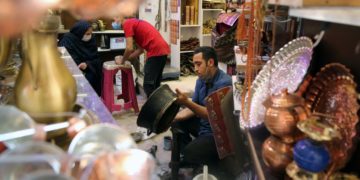Within a year, the Iranian rial has lost over 50% of its value. Whereas in March 2024, it was trading at 600,000 to the US dollar, one year later the rate has fallen to more than 1,000,000. This massive devaluation is driving inflation further, making imported goods more expensive, and placing a particular burden on lower and middle income groups in .
“Economic uncertainty means that worries about the cost of living are coming to the fore and political engagement is declining,” Mohammad Reza Farzanegan, an economic expert at the Center for Near and Middle Eastern Studies at the University of Marburg in central Germany, told DW.
“From an economic point of view, there is considerable doubt that weakening the middle class contributes to achieving the goals international political pressure would like,” he pointed out, referring to a new study he conducted with Nader Habibi, an academic at Brandeis University in the US.
It shows that the punitive economic measures imposed on Iran since 2012 — because of its controversial nuclear program, in an effort to — have massively hindered the development of the Iranian middle class.
If sanctions had not been imposed, the annual middle-class size would have been approximately 11 percentage points larger on average.
State-affiliated institutions benefit from sanctions
Farzanegan said that the shrinking of the middle class had led to increasing economic dependence on state-affiliated institutions: “While numerous private companies have suffered from the sanctions, state-affiliated companies, particularly those with ties to the Revolutionary Guards (IRGC), have been able to benefit. They have found ways to expand alternative trade networks and have strengthened their position on the market. This has further consolidated the economic power of the state by comparison with that of the private sector.”
Under the pressure, women are suffering more than men. Hadi Salehi Esfahani, an economist at the University of Illinois in the US, said that they were particularly affected by economic challenges when it comes to finding work, earning a living and even securing subsistence.
His latest research on the Iranian labor market shows that low economic growth, an ongoing recession as well as cultural factors and traditional role models, according to which men should be the main breadwinners, are seeing women be more easily pushed out of the labor market. It is becoming even more difficult for them to find a job or earn their own living.
Furthermore, there are structural disadvantages and discriminatory factors, including stricter recruitment criteria for women, a lack of opportunities to go up the ladder, and less pay for the same work.
The situation is not likely to improve over the coming months and could get worse. In February, signed a National Security Presidential Memorandum to restore ” of the Islamic Republic of Iran.” The aim is to persuade Tehran to renegotiate a by imposing tougher sanctions and increasing the economic pressure on the regime. The US particularly wants to choke , which comprise the main source of state revenue.
Tehran is trying to prepare by cutting energy subsidies
, Tehran has made plans to reduce spending, by cutting energy subsidies for instance.
But Iranian business journalist Mahtab Gholizadeh said that was unlikely to defuse the situation. “In the budget for the new Persian year (which began on March 21, 2025), the government estimated that the daily oil export target would be 2 million barrels. That will probably not be achieved with Trump.” She added that the budget deficit would likely grow and “the abolition of subsidies could mean that the country faces a severe wave of inflation.”
In recent years, the Iranian has increased significantly. There have been , for example in 2022 after the death in police custody of 22-year-old , and in 2019 against rising energy prices. In both cases, the protests were brutally suppressed.
“Growing dissatisfaction does not necessarily lead to organized political pressure,” said Farzanegan. “Households that have weakened economically have fewer resources to mobilize politically.”
He said that international sanctions that weakened the middle class would not lead automatically to more pressure on the regime. On the contrary, he said, they undermine the “the economic basis of a politically active social class and strengthen the power of the political system in relative terms.”
This article was translated from German.
The post Iran’s middle class bears brunt of economic crisis appeared first on Deutsche Welle.



















